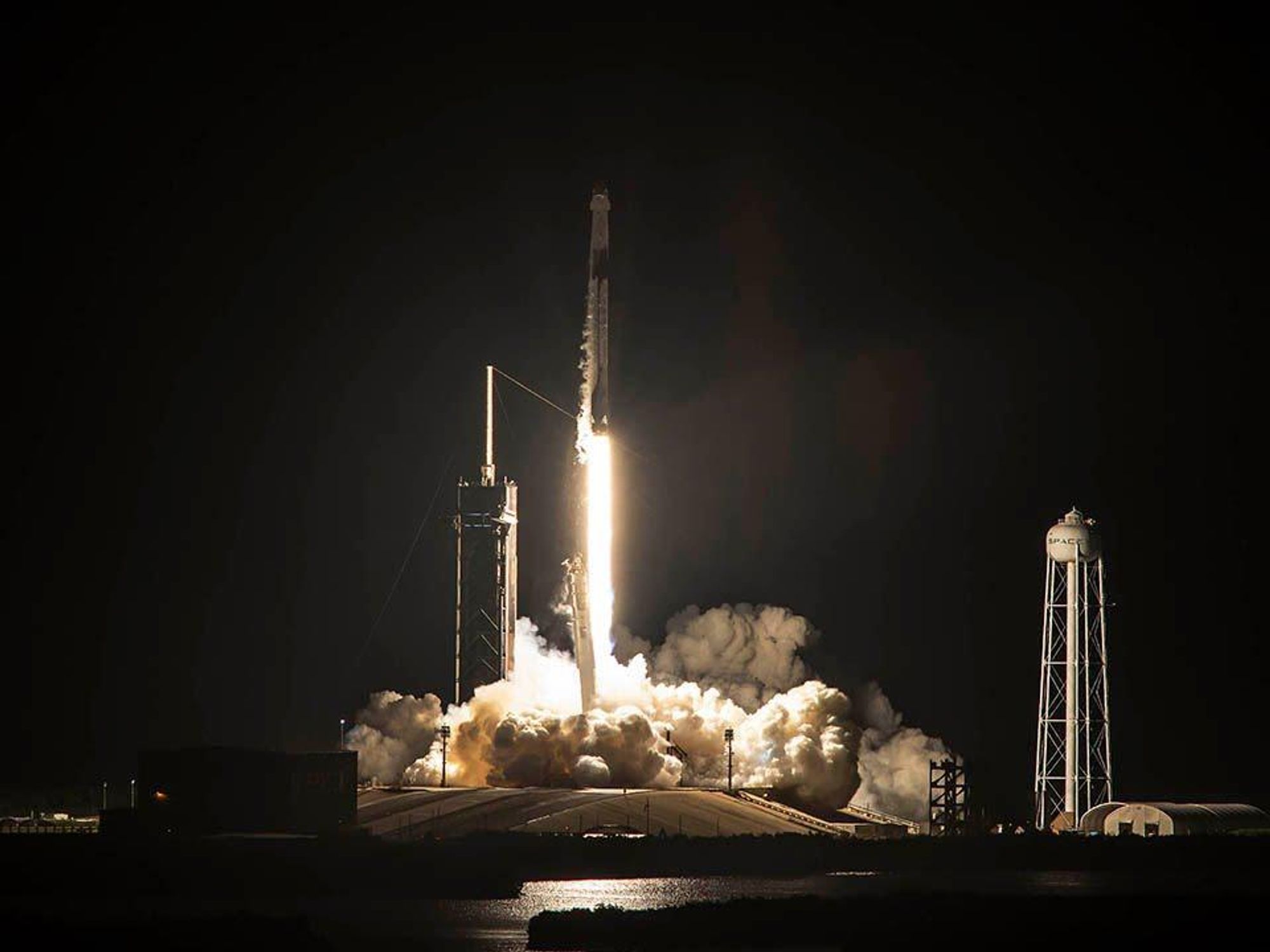With a Billionaire’s Backing, SpaceX Sends Citizen Spacefliers Into Orbit for a Mission Like No Other
GeekWire contributing editor Alan Boyle is an award-winning science writer and veteran space reporter. Formerly of NBCNews.com, he is the author of "The Case for Pluto: How a Little Planet Made a Big Difference." Follow him via CosmicLog.com, on Twitter @b0yle, and on Facebook and MeWe.

A tech billionaire and three other non-professional spacefliers blasted off today to begin the first non-governmental, philanthropic mission carrying a crew to orbit.
The founder and CEO of Shift4 Payments, Jared Isaacman, is paying what's thought to be in excess of $100 million for what's expected to be a three-day flight in a SpaceX Crew Dragon capsule.
Isaacman organized the Inspiration4 mission with SpaceX's help as a benefit for St. Jude Children's Research Hospital in Memphis. The 38-year-old billionaire kicked off the $200 million campaign with a commitment to donate $100 million himself.
SpaceX's Falcon 9 rocket lifted off from NASA's Kennedy Space Center in Florida at 8:02 p.m. ET (5:02 p.m. PT). "Punch it, SpaceX!" Isaacman told mission control.
On the webcast, every phase of the ascent drew raucous cheers from hundreds of SpaceX employees who gathered at the company's headquarters in California. Nearly half a million viewers watched the streaming coverage at its peak.
Minutes after liftoff, the rocket's reusable first-stage booster flew itself back to an at-sea landing on a drone ship in the Atlantic, while the second stage pushed the Crew Dragon the rest of the way to orbit.
After the Dragon reached orbit, Isaacman noted that he and his "all-civilian" crew had wedged their way to space through a metaphorical door that relatively few humans have gone through. "Many are about to follow," said Isaacman, an amateur jet pilot who's been trained to take control of the Dragon if its autonomous navigation system fails. "The door is opening now, and it's pretty incredible."
Although the flight started out from NASA-owned property, the space agency has minimal involvement in this mission.
Instead of heading for the International Space Station, as all of SpaceX's other crewed flights have done, this Crew Dragon will trace an orbit that rises as high as 363 miles (585 kilometers). That's higher than the space station, and higher than the Hubble Space Telescope. In fact, Inspiration4 will be humanity's highest-flying space trip since the space shuttle fleet's Hubble missions, which took place when the space telescope was at a slightly loftier altitude.
The high-altitude itinerary is in line with SpaceX's aspirations to go beyond Earth orbit — aspirations that Inspiration4 mission director Todd Ericson said were in line with Isaacman's view. "We want to start taking those first steps out toward becoming an interplanetary species, which means we've got to start working our way above low Earth orbit," Ericson told GeekWire during a pre-launch interview.
For this trip, SpaceX developed a cupola that's taking the place of the Crew Dragon's docking port and will provide a 360-degree view of Earth below or the sky above.
Today's launch marked the culmination of a process that began with a Super Bowl commercial and continued with months of training for Isaacman and his three crewmates. The training included hours upon hours of studies and simulations, a zero-gravity airplane flight, some nausea-inducing centrifuge sessions, high-G jet maneuvers and a climbing trip to Mount Rainier in May.
Isaacman's three crewmates were chosen in a variety of ways. They include:
- Hayley Arceneaux, a survivor of childhood cancer who became a physician assistant at St. Jude. Hospital officials chose Arceneaux to fly at Isaacman's invitation. She's the first person to go into space with a prosthesis — a titanium rod that was put in her left leg during treatment for bone cancer. At the age of 29, Arceneaux is the youngest human to go into orbit and the youngest American to go into space. (Dutch student Oliver Daemen holds the world record for youngest in space by virtue of July's suborbital flight on Blue Origin's New Shepard spaceship. He was 18 at the time.)
- Sian Proctor, 51, an Arizona-based educator and artist who's backing up Isaacman as the Crew Dragon's pilot. That makes her the first Black female pilot on an orbital space mission. Proctor was chosen through an online competition for users of Shift4's online payment system.
- Chris Sembroski, 42, an Air Force veteran who lives in Everett, Wash., and works for Lockheed Martin as a data engineer. Sembroski has been a space buff since his youth, and entered Inspiration4's charity sweepstakes for the fourth spot on the mission. His ticket wasn't picked, but the winner turned out to be a college buddy of his. That buddy decided not to go and picked Sembroski to fly instead.
Sembroski will be in charge of managing the payloads aboard the Crew Dragon — including medical experiments, flown-in-space items that will be auctioned off to benefit St. Jude, and a ukulele that he'll play in space.
During the three days that they're scheduled to spend in orbit, the Inspiration4 foursome will monitor their radiation exposure, glucose levels and other health indicators. They'll conduct a variety of educational and outreach activities, including schoolroom classes and contacts with cancer patients. But they'll also have plenty of time to look out at Earth through their custom-made cupola.
"Of course I'm going to be looking down at my home in Western Washington," Sembroski said before liftoff. "I'm also looking to see what I don't see — and that's going to be lines on a map or those walls that seem to separate all of us."
This story originally appeared on GeekWire.
GeekWire contributing editor Alan Boyle is an award-winning science writer and veteran space reporter. Formerly of NBCNews.com, he is the author of "The Case for Pluto: How a Little Planet Made a Big Difference." Follow him via CosmicLog.com, on Twitter @b0yle, and on Facebook and MeWe.




